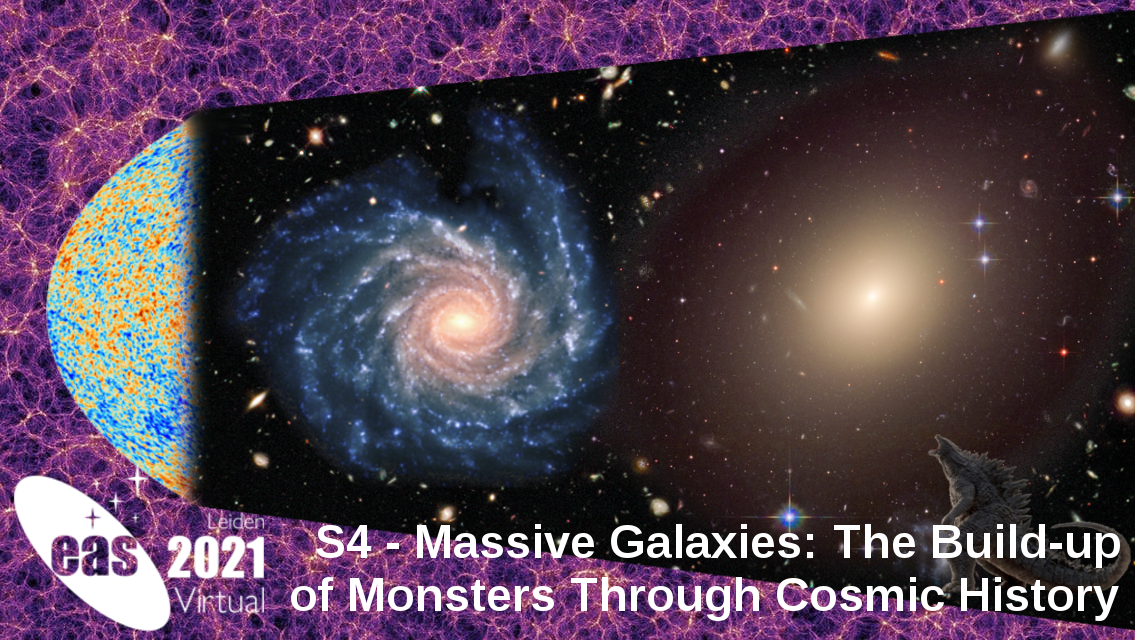Symposium S4
1-2 July 2021
Massive Galaxies: The Build-up of Monsters Through Cosmic History

Aims and scope
For decades, astronomers exploited the brightness of the most massive galaxies to literally illuminate our knowledge of galaxy formation and evolution at all cosmic times. At small look-back times (z<1), galaxies with stellar mass exceeding 1011 M☉ account for half of the stars ever formed. They mostly appear as quiescent and their ages suggest that they formed the majority of their stars at around the same epoch at z~2-3, when the Universe experienced the peak of its star formation activity. Although these systems have been extensively studied, the details of the process(es) by which these galaxies transform from actively star forming to quiescent are still not understood.
In recent years, the awareness has grown that the assembly of massive galaxies is drawn by a mutual interaction between the central massive black holes, the interstellar medium, and the surrounding gas reservoir. Simulations have shown that, on the one hand, the growth of a massive galaxy is regulated by its close environment via galaxy interactions, mergers, and gas inflows. On the other hand, newly formed stars can influence future generations of stars within a galaxy, by ionizing and enriching the existing gas reservoir. To date, however, firm observational constraints of these theoretical predictions are still missing.
The latest generation of instruments such as VLT/MUSE, the Keck Cosmic Web Imager, and ALMA are at the forefront of this field. Thanks to the superb quality of the delivered data, we are now able to trace the gas in its various phases around and inside massive galaxies up to high redshifts (z>4) and to discover the stellar content up to the epoch of ionisation. Complementary, this observational effort is sustained by cutting edge simulations that are able to trace the life of galaxies in exquisite detail.
As the future generation of ground and space telescopes is being built, this symposium aims at catalyzing ideas to fully exploit the wealth of currently existing information and to pave the way to future exploration of the new facilities.
Programme
At stake are the following questions:
- How do massive galaxies evolve before and after quenching?
- How fast can galaxies grow massive in the early universe? / How massive can galaxies grow in the early universe?
- How should we interpret the role of AGN? Is AGN feedback the most important process in shaping the massive end of the galaxy population?
- How quiescent are quiescent galaxies and how should we define ``quiescence''?
- When did the first quiescent galaxies appear?
- Which datasets are we currently lacking to assess these issues?
- How is our scientific effort limited by the current technology (from both an observational and a computational point of view)?
- How well can we account for all the massive galaxies throughout cosmic history?
Invited speakers
- Yannick Bahé
- Claudia Cicone
- Tiago Costa
- Cristina Garcia-Vergara
- Carlos De Breuck
- Melanie Habouzit
- Nina Hatch
- Jacqueline Hodge
- Dylan Nelson
- Dominik Riechers
- David Rosario
- Ignacio Trujillo
- Debora Sijacki
- Dominika Wylezalek
Scientific organisers
- Caroline Straatman (UGent, caroline.straatman 'at' ugent.be)
- Celine Peroux (ESO, celine.peroux 'at' gmail.com)
- Emanuele Paolo Farina (MPA, emanuele.paolo.farina 'at' gmail.com)
- Fabrizio Arrigoni-Battaia (MPA, arrigoni 'at' mpa-garching.mpg.de)
- Roberto Decarli (INAF, roberto.decarli 'at' inaf.it)
- Vincenzo Mainieri (ESO, vmainier 'at' eso.org)
Contact
Emanuele Paolo Farina (MPA, emanuele.paolo.farina 'at' gmail.com)
Updated on Tue Mar 02 22:11:33 CET 2021
|